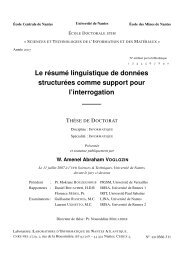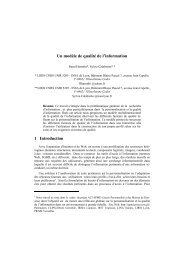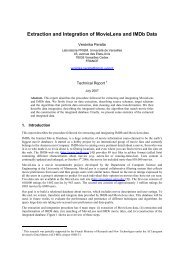60 J Intell Inf Syst (2006) 26: 59–73each <strong>summary</strong>, expressed with fuzzy linguistic labels, symbolizes a concept that exists withinthe data.This paper proposes a querying mechanism for users to efficiently exploit the hierarchicalsummaries produced by SAINTETIQ. The first idea is to query the summaries using the vocabulary<strong>of</strong> the linguistic variables defined for the summarization process. Although linguisticterms are used in the expression <strong>of</strong> queries, the querying process is clearly boolean. Since thequerying vocabulary is the one used within the summaries, the linguistic terms have becomethe attribute values in the summaries and query answers contain these linguistic terms only.Then, basic queries such as “how are, on attribute(s) A k , the tuples which are d i, j on A i ”(e.g., “what is the hardness <strong>of</strong> metals whose fusion temperature is high”), can be answeredvery efficiently as the querying process relies on boolean operations. Moreover, the algorithmtakes advantage <strong>of</strong> the hierarchical structure <strong>of</strong> the summaries, which also works as a kind <strong>of</strong>multidimensional index, in order to obtain the answer more rapidly. The gain is particularlyimportant in case <strong>of</strong> a null answer, as only a small part <strong>of</strong> the summaries hierarchy has to beexplored, instead <strong>of</strong> the entire relation.<strong>Querying</strong> the summaries as explained above is interesting as it makes it possible to rapidlyget a rough idea <strong>of</strong> the properties <strong>of</strong> tuples in a relation. In case <strong>of</strong> null answers, it clearlysaves time: examining the top <strong>summary</strong> <strong>of</strong> a hierarchy is enough to know there is no answerfor an empty result set query. Suppose for instance that one can access several <strong>database</strong>s.<strong>Querying</strong> their summaries can allow to rapidly determine which ones are likely to give ananswer.In other cases, a rough answer is <strong>of</strong>ten not enough. Thus, the second idea is to query the<strong>database</strong> through the summaries, which would be done by 1—selecting some summaries fromthe <strong>summary</strong> hierarchy w.r.t. criteria specified by the query and 2—retrieving the <strong>database</strong>records’ identifiers from the selected summaries. This process is then related to the “flexiblequerying <strong>of</strong> relational <strong>database</strong>s” trend <strong>of</strong> research. Indeed, in this case, linguistic terms areused in the expression <strong>of</strong> queries, and the answer would be composed <strong>of</strong> tuples from theoriginal relation, ranked according to a degree <strong>of</strong> satisfaction to the query.The next section describes flexible queries <strong>of</strong> <strong>database</strong>s and their features compared toclassical queries. It exposes some earlier works done in this field by other researchers. Section3 presents an overview <strong>of</strong> the SAINTETIQ model, briefly depicting the representations <strong>of</strong>summaries and the different steps <strong>of</strong> the <strong>summary</strong> building process. It also highlights thedistinctive aspects <strong>of</strong> our approach. Section 4 thoroughly explains how advantage can betaken from the use <strong>of</strong> the SAINTETIQ summaries hierarchies in a flexible querying process.Expression <strong>of</strong> queries, selection <strong>of</strong> summaries and formation <strong>of</strong> results are then reviewed.2. Flexible querying <strong>of</strong> regular <strong>database</strong>sA flexible querying process operating on relational <strong>database</strong>s searches the tuples for adequacyto a query using an extension <strong>of</strong> a standard language, usually SQL. According to Larsen(1999), a flexible querying process <strong>of</strong> a <strong>database</strong> can be divided in three steps: extension <strong>of</strong>criteria, selection <strong>of</strong> results and ordering.The first step uses similarity between values to extend the criteria, i.e. to allow gradedsemantics for any criterion, which can now express “around 20” instead <strong>of</strong> being limited tothe binary semantics <strong>of</strong> “equal to 20” or “between 18 and 22”. The second step, namely theselection <strong>of</strong> results, determines which data will participate in the answer to the query. Thesedata are afterwards referred to by the term “results”: the set <strong>of</strong> all results constitute the answerto a query. The last step (ordering) follows from the extension <strong>of</strong> criteria. It discriminatesSpringer
J Intell Inf Syst (2006) 26: 59–73 61among the results on the basis <strong>of</strong> their relative satisfaction to the graded semantics: a value<strong>of</strong> 20 is better ranked than a value <strong>of</strong> 18.The fuzzy set theory is <strong>of</strong>ten used in flexible querying (see Dubois and Prade, 1997)because it provides a formal framework to handle the graduality and vagueness inherent tonatural language. The following works, which are representative <strong>of</strong> the research on flexibilityin <strong>database</strong> querying, exemplify the use <strong>of</strong> fuzzy sets. They are essentially characterized bya tuple-oriented processing, the possibility to define new terms and especially, the use <strong>of</strong>satisfaction degrees.2.1. SQLfThe querying language SQLf, proposed by Bosc and Pivert (1994), is an extension <strong>of</strong> SQLaiming at “introducing fuzzy predicates into SQL wherever possible”. An augmentation <strong>of</strong>both the syntax and semantics <strong>of</strong> SQL is performed so that most elements <strong>of</strong> a query can befuzzified. These elements include operators, aggregation functions, modifiers (very, really,more or less), quantifiers (most, a dozen) as well as general description terms such as youngor well-paid.Different interpretations are possible for the same query, for instance fuzzy sets crispcardinality or Yager’s ordered weighted averaging operators (Yager, 1988). It occurs for eachrecord and yields a grade <strong>of</strong> membership (<strong>of</strong> the record to the query) which is used to rankthe results. An example <strong>of</strong> query in SQLf is “select 10 dpt from EMPLOYEE group bydpt having most-<strong>of</strong> (age = young) are well-paid” where standard SQL keywords are inbold face, and dpt and age are attributes from a relation named EMPLOYEE. The queryselects the 10 departments which have the best satisfaction <strong>of</strong> the condition “most <strong>of</strong> theyoung employees are well-paid”.2.2. FQUERYFQUERY (Kacprzyk and Zadro«zny, 2001) is an integration <strong>of</strong> flexible querying into anexisting <strong>database</strong> management system, namely Micros<strong>of</strong>t Access. The system allows querieswith vague predicates expressed through fuzzy sets. Queries may contain linguistic quantifiersand attach different levels <strong>of</strong> importance to attributes. In doing so, the authors try to applythe computing with words paradigm and, eventually, deal with linguistic values, quantifiers,modifiers and relations.FQUERY uses fuzzy sets for the imprecision aspect and performs a syntax and semanticsextension <strong>of</strong> SQL. Linguistic values and quantifiers are represented as fuzzy sets. On thesemantics side, the query is considered as a fuzzy set resulting from the combination <strong>of</strong>fuzzy sets from linguistic values and quantifiers. Accordingly, each record selected by aclassical SQL query, has a satisfaction degree used in a ranking step since it indicates howwell the record corresponds to the query.2.3. SummarySQLDeveloped by Rasmussen and Yager (1997), SummarySQL is a fuzzy query language intendedto integrate summaries into a fuzzy query. The language can evaluate the truth degree<strong>of</strong> a <strong>summary</strong> guessed by the user. It can also use a <strong>summary</strong> as a predicate in a fuzzy query.A <strong>summary</strong> expresses knowledge about the <strong>database</strong> in a statement under the form “Qobjects in DB are S”or“QRobjects in DB are S”. DB stands for the <strong>database</strong>, Q is a linguisticSpringer







